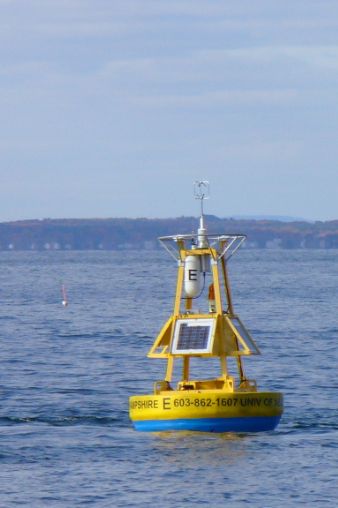UNH/WHOI Air-Sea Flux Buoy Data Information and Access
The links below provides THREDDS access to our available field buoy air-sea flux datasets. Metadata within the netCDF files should contain the documentation to inform data usage policy and to support initial investigations. We appreciate any feedback as well as opportunities to collaborate in the application of these data. If you encounter any trouble or have questions, please send an email to doug.vandemark@unh.edu
- UNH Gulf of Maine flux buoy data via THREDDS
- UCONN/WHOI CLIMODE AND SPURS flux buoy data via THREDDS
- Coming soon NSF OOI flux buoy data via THREDDS
These data represent averages of 20 min. flux and scalar estimates, usually collected hourly from 0 to 20 minutes past the hour. For the UNH (JLMO) datafiles all segments are provided without filtering. Filtering to leave only the most reliable data, avoiding rain or other effects, involves setting thresholds on variables including relative humidity and standard deviations in the temperature and vertical velocity data. Details and example matlab code are provided in the following QA/QC document:
Any data fields requiring use of bulk flux algorithms were computed using COARE 3.5 as detailed in Edson et al. 2013, DOI: 10.1175/JPO-D-12-0173.1.
Supporting material for 2022 EC155 CO2 trace gas analyzer study
Experiment data files and matlab scripts used in the study of Vandemark et al. (2022) are provided here as a zip file. This study investigates an approach to attenuate the effects of buoy platform motion on high rate atmospheric CO2 measurements. The goal is to improve the fidelity of eddy covariance mass flux measurements collected at sea on moving platforms.

Moored air-sea flux measurements in support of improved satellite ocean observations
UNH has been working closely with J. Edson at the Woods Hole Oceanographic Institution in a team effort to collect a series of long-term ocean field datasets of air-sea momentum, mass, and heat flux using several different buoys and platforms. These in situ measurements of wind stress are being used support improved interpretation of ocean satellite measurements including ocean surface wind vector as collected by recent QuikSCAT, ASCAT, OSCAT and RapidSCAT sensors. We are also working with S. Miller at SUNY/Albany to improve mass flux measurements using refined trace gas analyzers.
References
Bigorre, S., R. A. Weller, J. Lord, J. B. Edson, and J. D. Ware (2013), A surface mooring for air–sea interaction research in the Gulf Stream. Part 2: Analysis of the observations and their accuracies. J. Atmos. Oceanic Technol., 30, 450–469, doi:10.1175/ JTECH-D-12-00078.1.
Edson, J. B. and Coauthors (2013), On the exchange of momentum over the open ocean. J. Phys. Oceanogr., 43, 1589–1610, doi:10.1175/ JPO-D-12-0173.1.
Plagge, A, J. B. Edson, and D. Vandemark (2016), In Situ and Satellite Evaluation of Air–Sea Flux Variation near Ocean Temperature Gradients. J. Climate, 29, 1583–1602. doi: http://dx.doi.org/10.1175/JCLI-D-15-0489.1
Farrar, J.T., Rainville, L., Plueddemann, A., Kessler, W.S., Lee, C., Hodges, B.A., Schmitt, R., Edson, J.B., Riser, S.C., Eriksen, C.C., Fratantoni, D. (2015), Salinity and temperature balances at the SPURS central mooring during fall and winter. Oceanography 28(1):56–65, http://dx.doi.org/10.5670/oceanog.2015.06.
Vandemark, D., M. Emond, S. D. Miller, S. Shellito, I. Bogoev, and J. M. Covert (2022), A CO2 and H2O gas analyzer with reduced error due to platform motion, J. Atmos. Ocean. Tech., submitted.